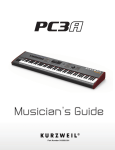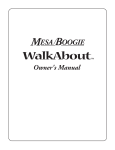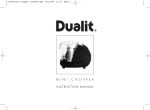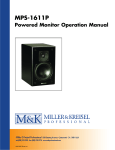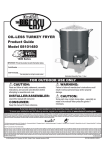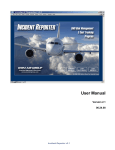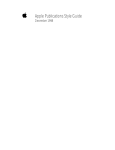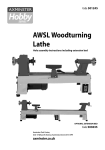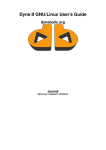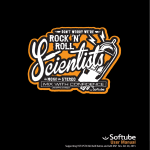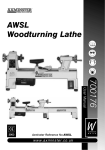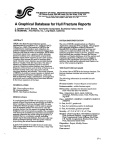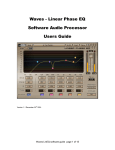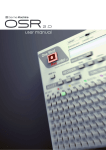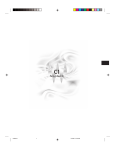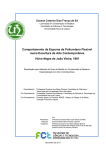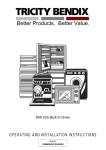Download Renaissance Equalizer User Manual
Transcript
Renaissance Equalizer Table of Contents Chapter 1 Introduction 2 Chapter 2 Renaissance EQ Quick Star t 3 Chapter 3 The Interface 4 Chapter 4 The Filt ers 6 Chapter 5 The Controls 11 Chapter 6 Factor y Presets 16 Chapter 7 FAQ’s 20 Chapter 8 An EQ Essay With Wonderful Tips 21 Renaissance Equalizer Plug-in Manual 1 Chapter 1 - Introduction Welcome to the Renaissance Equalizer manual. Since the development of Q10 by Waves in 1993, there has been an increasing need for high-quality “sweet” EQs. To answer the need, Waves created the Renaissance Equalizer. This EQ is a 6-band audiophile equalizer for professional audio production. It offers a choice of 6, 4, or 2 band operation for optimum use of processing power. Stereo, dual-mono, and mono implementations are part of the EQ, although not necessarily available in all platforms. The following manual explains how to use the Renaissance Equalizer. Waves Renaissance Equalizer 2 Renaissance Equalizer Plug-in Manual Chapter 2 - Quick Start Please, do yourself a Power Tips favor: refer to the WavesSystem Manual for a full explanation regarding standard Waves controls. Default settings and behavior 1. The REQ is slightly different from the Q10, in that when you first open the EQ, the bands will be “on”. The only exception to this is the 6-band, in which the 1st band is off because it is a low cut filter (highpass), and is not desirable to be switched in until needed. 2. Preview the source track (or play audio, depending on your platform). 3. Click and drag any dot (band marker) in the graph to change the Gain and Freq of that band. The default settings are designed to be usuable immediately for a wide range of applications (see the Factory Setup Notes for explanations of “Gerzon shelves” and “Baxandall”, and so forth). 4. Double-click any band marker to turn it on or off (or just drag it to turn it on). 5. Option-drag any band marker to adjust the Q (left/right movement) [PC uses Alt-drag]. Vertical movement always changes the gain. 6. Command-click any band marker to change the filter type; it will toggle to the next type available for that band (not all bands have all filter types).[PC does not support this]. 7. Control-drag any band marker to constrain that band to one direction (the first you move in, either Gain or Frequency; if option-control-drag, then it will be Gain or Q). [PC uses Control-drag, and AltControl-drag]. Renaissance Equalizer Plug-in Manual 3 Chapter 3 - The interface With a functional design based directly on the Waves Q10 Equalizer, the Renaissance EQ has a single window with full graphing, numerical display and control, and color-coordinated objects for intuitive operation. All buttons, controls, meters, and faders operate with a common set of functions called the WaveSystem. If you are unfamiliar with it, please do a quick read of the WaveSystem manual. The information you’ll find there works for all Waves plug-in processors, so you only have to learn it once! It is highly worth your time, as Waves offers controls that are absolutely unavailable on competitors products, such as simultaneous control of multiple values (use the selection rectangle or shift-click to select desired controls, then drag on any one of the selected controls), and much more. You can drag directly on any button to change its value, click on it and type in a value, or click on it and tweak the value with the arrow keys. You may also drag any marker in the graph directly to change the EQ. Graphical control Simply click and drag any marker in the graph for easy control of Frequency and Gain. On the left edge of the screen you’ll see little arrows near the labels so as to make it clear which way to move the mouse. Some controls work left/right, and some up/down. (Hint: WaveSystem manual has the clues on using this feature for real power). By using the X/Y controls of the mouse in combination with the Option, Command, and Control keys, you can have complete control of the EQ band with a very small number of clicks and keypresses. Legend of the Mouse Moves • To control the Q instead of Frequency, just press the Option key while dragging (you don’t even have to stop holding the mouse down, just press the Option key to switch to the Q value). [PC uses the Alt key and supports on-the-fly switching to Q control]. • To change the filter type of the band, press the Option-Command keys and click on the band. Each click will toggle to the next filter type. [PC doesn’t support this]. • To turn a band off, you can Command-click, or double-click the band. [PC doesn’t support this]. • To turn a band on, simply drag it, or double-click it. • To constrain the band marker to moving in just the X or Y direction, press the Control key while 4 Renaissance Equalizer Plug-in Manual dragging. If you want to change to the other direction, simply release the key, then press it again,then move the mouse in the preferred direction (again, you don’t have to release the mouse).[PC uses Control-drag, but does not support on-the-fly directional changes; you have to release the Control key and mouse, then press Control and click again to drag in another direction]. Keyboard control Though the Renaissance Equalizer makes use of an intuitive graphic interface which can be controlled almost entirely via mouse if preferred, there is also complete keyboard commands for those who prefer to work that way. All parameters may be selected, and their values entered directly from the keyboard; TABbased control is used to navigate through all parameters and Value Windows, and to move from one parameter to another when multiple items are selected. Multiple Selection Whether working with the graph or keyboard, one of the most powerful functions is the ability to select and drag multiple controls or band markers at the same time. If you have created a complex EQ curve, for example,using a high shelf and a small presence boost, you can simply select both band markers and drag on either to change them together. Alternatively, you could drag a selection rectangle around both of the band’s Frequency value windows (or shift-click on bands that are not beside each other), then simply click and drag on any one of the selected value windows to change all of them. Using the Control, Option, and Command keys as described in the previous section also applies when multiple bands are selected in the graph, so you might start to see how powerful these features can be! Renaissance Equalizer Plug-in Manual 5 Chapter 4 - The filters What is in each band Each of the bands of EQ provided by the Renaissance Equalizer are not the same, unlike the Q10. This has been done to optimize the processing requirements for as many professional users as possible (and for the platform they use). Bands 1 and 6 are common to all components of the REQ, that is, if you select the 2-band component from your plug-in menu,then the 2 bands have the same filter options as bands 1 and 6 from the 6-band version. The 4-band version adds bands 2 and 5, and the 6-band version adds bands 3 and 4. Band 1 and 6 have cut filters, resonant shelves, and bell filters. (1 is low cut and shelf, 6 is high cut and shelf). Bands 2, 3, 4, 5 all have resonant shelves and bell filters. (2 and 3 have low shelves, 4 and 5 have high shelves). Default values Each component (2-,4-, or 6-band) of the REQ has a different default setup to provide a highly-usable general setting. When you insert the REQ into your editor, you’ll see that all bands are already switched “In” by default, except in the 6-band EQ, in which Band 1 is intentionally “Out” because it is a low cut filter. Since the low cut is the most commonly used cut filter, it was included in the default, but we didn’t presume that you wanted to use it by default! For complete details of the default setup and the factory presets, see the Factory Presets chapter. What the filters are You might be wondering what “resonant shelves” are, or if you’ve already been using the Renaissance EQ and are just now reading this sentence, you might be doing so to find out just what a Gerzon Shelf or a Baxandall filter really is. Resonant shelf filters Michael Gerzon proposed the idea of a resonant shelf in a confidential paper to Waves in 1994. Analog filters (specifically, Pultec) had already achieved this type of EQ behavior by using both the cut and boost knobs simultaneously (see Chapter 8 for many more great details).Mr. Gerzon had defined a way to make this acoustically-desirable behavior into a single filter type. He did not live to see the implementation of his proposal. We have named some of the presets using these shelves in his honor although our implementation is not quite exactly his proposal. Instead, they are a compromise between his idea and the great sound of the Pultec filters, with thanks to suggestions from Craig “Hutch” Hutchinson. 6 Renaissance Equalizer Plug-in Manual The two main differences in these shelves from traditional shelves, such as those in the Q10, are the visibly obvious curves of the shelf (shown here), and that you can change the Q of the shelf, which shifts the steepness of the slope. In a way, you can think of these as “parametric shelves”. Q=1.41,4kHz High shelf With the highest available Q of 1.41, the slope is steepest and the “resonant” parts of the curve are at their most extreme. The lowest Q is 0.71, which is very similar to the gentleness of the slopes in the Q10 shelves. Michael Gerzon suggested that values of Q just under 1.00 would be pleasing for most applications. The classic Gerzon Shelf setting is a Q of 0.99, with low and high shelving at 250Hz and 4kHz, respectively. Variations of this shelf are in the factory presets of each REQ component (2,4, or 6 band). For more extensive suggested uses of the resonant shelves, please explore the small but powerful setup library for the Renaissance EQ. Cut filters These are sometimes called “pass” filters in the USA, in synthesizers,and by design engineers; highpass filters are the same as low cuts, lowpass filters are the same as high cuts. Again, a variable Q value makes these cut filters distinctively different from typical cut filters. The Q changes the slope of the line, plus includes a bump in the frequency response that allows the filter to be more musical and pleasing, while still performing the basic operation of a cut filter: to “clean up” unwanted frequencies outside of a given range. Initially, it might seem that using a sharp filter would be the best thing to really remove unwanted frequencies. However, if a very sharp brickwall filter is employed to cut off these frequencies, there is a psychoacoustic effect of making the sound very dull (when using a high cut). By allowing a few of these frequencies to remain, the removal of frequencies is performed and the resulting sound is sweeter and not as dull. Please note that this situation is not applicable to multimedia or other bandlimited requirements such as various digital conversions, which do require very sharp brickwall filtering. The REQ filters are designed for the most musical and magical results for pro audio. Renaissance Equalizer Plug-in Manual 7 Bands 1 and 6 are third-order filters (equal to 18dB/octave). When the Q=1.0, then they are indeed 18dB/octave, without the bump, as seen below. 3rd Order Filter Curves, Q = 1.0 In order to show the bump of a higher Q value, which is below the edge of the graph of the REQ, here is a screenshot of the Waves PAZ real-time analyzer. It was created by a sine-wave frequency sweep of a high cut filter at 2kHz, with a Q=1.41: Curve of a High-cut Filter, Q = 1.41 When the value of Q is higher than 1.0, the notch and bump actually give a higher slope than a 3rd order filter, but still allow some of the higher harmonics to pass thru, although greatly reduced. When the value of Q is at its smallest (0.71), the slope is slightly less than a 2nd-order filter, about 10dB/octave: 8 Renaissance Equalizer Plug-in Manual Q = 0.71, A Slope of About 10dB/octave Bell filters (parametric) George Massenberg invented the parametric equalizer, and most people are quite accustomed to using them. Almost completely without exception, they have symmetrical response characteristics. However, when we use an equalizer to boost, it is nearly always for tonal correction, and when cutting, for removal of bothersome artifacts (see Chapter 8 “An EQ Essay” for a rather entertaining viewpoint about EQ). The asymmetrical filters had been described by several audio researchers and designers (including Mitra,“Hutch” Hutchinson, and others), but not included in any commercial products to our knowledge; Waves chose to include this type of filter simply because it sounded better for high-end use. What does symmetrical mean? Simply that most equalizers have exactly the same response in the boost or gain of a bell filter, seen here: Symmetrical bell filter. Engineer ing Q=1.0,from the Q10 Renaissance Equalizer Plug-in Manual 9 However, an asymmetrical response,is, in a way, the most “natural”thing for an equalizer to do in the analog domain. To put it in other words, for a constant value of Q,a boost and a cut at the same frequency of a bell filter will not have the same shape. Here is the same setting (engineering Q=1.0) but on the REQ: Asymmetrical bell filters of the RenEQ 10 Renaissance Equalizer Plug-in Manual Chapter 5 - The Controls The faders, meters, peak numeric meters, and method of changing values are part of the WaveSystem manual. Please refer to that document for such information (which is common to all Waves products and only need to be learned once). Individual band controls The small controls beneath the frequency curve display are the Value Windows for Gain, Frequency, and Q for each band. At the bottom of each column is the control to switch each band In or Out, and to choose the filter type for that band. Top to bottom: Gain, Frequency, Q, In-out/Type Gain Gain may be adjusted in the range +18.0 to -18.0dB, in increments of 0.1dB via the Gain Value Windows or by ‘dragging’ the EQ curve. The displayed frequency response graph shows a range of +/- 18.0dB. Freq The Frequency control displays the center frequency for each band when a bell filter is selected. When in cut or shelf modes,the Freq parameter controls the corner frequency of the filter. The Frequency control values are adjustable in one-sixteenth-tone steps (96 steps per octave), rounded to the closest integer. The left/right arrow keys may be used to step the selected Freq value in one-sixteenthtone increments. Renaissance Equalizer Plug-in Manual 11 Q The Q control displays the Q value, which functions differently for each filter type. • Bell - Q corresponds to the width of the frequency range for that band. • Shelf - Q controls the slope of the “side” of the shelf and the resonant dips and peaks. • Cut - (bands 1 or 6 only), Q controls the slope of the cut filter (from about 10dB/oct to 18dB/oct), plus controls the “bump” in the slope, as explained in the previous chapter. In all cases, when Q is a higher value (bigger number) the slopes of all filters are generally steeper; bells are narrower, cut and shelf filters are more sharply sloped. More about Q Q is a way of expressing the frequency width of a filter in relation to the center frequency of the filter band and may be represented by the mathematical relationship: Fc/Fw (center frequency divided by frequency width at the traditional ‘-3dB point’, both in Hertz). For example, a Q of 2.0 at 1,000Hz gives a bandwidth of 500Hz (1000Hz divided by 2). In the Renaissance Equalizer, the Q value is the traditional “engineering Q” for the bell filters, but only for positive gain. When used as a negative gain, the filter’s asymmetrical property, described in the previous chapter, is actually narrower than an equalizer with symmetrical behavior. Therefore, an REQ bell filter with negative gain sounds sharper; it would be equivalent to a higher Q on a symmetrical bell equalizer, roughly double the Q of its value. In-out/Type At the bottom of the controls is a row of dual-toggle buttons.Each has two toggles; one to switch each band In or Out, and one to control the Filter Type. Please recall that not all bands have the same complement of filter types. Bands 1 and 6 have cuts, bells, and shelves. Bands 2 and 3 have bells and low shelves; bands 4 and 5 have bells and high shelves. Click the Filter Type button to toggle through the available selections for that band. On some platforms, you can option-click the Filter Type buttons to display a popup for direct selection; not all programs support popups in plug-in windoids, so the toggle mode is the default method of selecting the filter. Each filter curve is represented by an icon, shown here from left to right. Low cut, Low shelf, Bell, Bell, High shelf, High cut To switch the band In or Out, click the left edge of the control; when the band is In,the control will illuminate with the corresponding color of the band marker. 12 Renaissance Equalizer Plug-in Manual Trim One special feature of 48-bit processing is the ability to use some headroom to completely avoid internal clipping. The REQ automatically eliminates any clipping in each band (which could occur in the Q10 and other equalizers). Such clips would not be indicated on input or output meters, but would certainly affect the signal. Because of this feature in REQ, input gain controls are unnecessary; only an output gain control is needed ,a s it is certainly possible to clip the output by boosting the EQ of an already-hot signal. Fortunately, the same headroom allows the REQ to calculate exactly how far “over” a signal goes beyond 0dBFS (full scale digital). In the center area just above the meters is the Trim button, calibrated in dB. Just below it is the clip light, shown illuminated here; the Trim button indicates a signal 3.1dB below full-scale. The positive value of the number indicates that there is still some headroom available, although we’re close to full-scale (0dB FS).. If there was headroom, such as in this example, the value is positive (and the clip light is not illuminated), which shows the faders can be moved upward 3.1dB without any clipping. This is sometimes called “margin” on some processors and recorders and simply shows how close the signal came has come to 0.0dBFS (full scale digital). • To Trim the faders, simply click the Trim button once to automatically move the faders by the value shown in the button. When you do so, Trim will reset to “12.0”, the maximum positive gain allowed (for reasonable safety in such matters). • To reset the Trim (and the meters) without changing the faders’ values, click anywhere in the meters or between them.If you accidently click the Trim and did not want to, most Macintosh platforms support the WaveSystem “z” key function; simply press the z-key (no modifier keys) to Undo the last action. [PC does not support this]. Both platforms support the Undo button at the top of the plug-in windoid. In this illustration, the signal has clipped (as shown by the red clip light) and needs to be reduced 3.9dB (so the negative sign indicates which way the level must go). As in the previous example, clicking directly on the number (-3.8) will Trim the faders by the amount indicated; here, the faders will be reduced 3.8 dB, to avoid clipping. Renaissance Equalizer Plug-in Manual 13 Link Using the REQ as linked stereo or dual-mono equalizers is easily chosen by using the Link button, located below the meters. • When the Link button is on (showing half yellow and half red), then changes to the equalizer affect both channels simultaneously, in all controls of the EQ (gain, freq, Q, filter type, in-out) and in the output gain faders. • For separate channel EQ (or dual-mono), click the Link button to turn it off, then select either the Left or Right button to adjust the selected channel. In the example shown, the Linking is off, and the left channel is selected for adjustment. The right channel is graphed in red, the left is graphed in yellow. Separate (unlinked) equalization of L and R (or dual-mono) Using Linked offsets It is possible to unlink the channels,set them to different gains (even different filter types and Q values), then re-link them. When you move one,the other channel will track the changes in values, even if you toggle to different filter types. Kindly note that if you type in a new gain value, then the typed gain value will be input to both channels, eliminating any gain offset; if you drag the band marker or gain value,then the gain offset between the bands will be maintained. Copy/paste in unlinked mode The WaveSystem offers many unique functions, including the ability to copy and paste values within a plugin, even if between different types of controls. For the REQ, copy/paste operations are slightly more flexible than the WaveSystem, so the differences are described here. One unique function of copy/paste is to be able to simultaneously duplicate settings between left and right, either for one or multiple bands. 14 Renaissance Equalizer Plug-in Manual For example, in the graphic shown below, if it was needed to make Band 1 (red line) to have the same -1.9dB setting as the Band 1 Right (yellow line), simply click on the Band 1 marker, then press the ‘c’ key (no modifier keys). This copies the values of that band into the internal Waves clipboard (not the system clipboard). Then, click the Right button beside the Link button; you’ll see the band marker jumps down to show it is controlling the right channel: Finally, click on the Band 1 marker, and press the ‘v’ key to paste the value: To copy the entire left or right channel, you could select-and-drag all the band markers, press ‘c’, switch to the other channel, select-and-drag all the markers again, then press ‘v’ to complete the paste. Alternatively, you could select all the Value Windows (numerical buttons below the graph) and perform the ‘c’ and ‘v’-key operations,if supported on your Mac editor. [PC does not support this]. You may select any group of controls for copy/paste; for example, you could select only the Freq buttons to be pasted to the other channel, or shift-select discontiguous controls, and so forth. Linking with automation When using automation in your editing program, the linking button is not automated, nor is its status saved as part of a setup. This allows you to load a setup into only one or the other channel for dual-mono use. There is a downside to this functionality, which is that true dual-mono automation is not possible at the present time within an unlinked stereo REQ. The automation systems of most editors only controls one channel, so any settings you try to save or automate on the other channel will not be written into the automation. If you have complex EQ that requires fully total-reset automation on each channel (whether dual-mono or L/R mastering), you should use two completely separate mono REQ processors and automate them independently. Flat Clicking on the Flat button will switch all bands Out and set the Gain values of all bands to 0.0dB. The bands are switched Out in order to ensure a flat response, as Cut filters are not affectee by the Gain value. Output fader values are not changed by the Flat button, nor are any Freq, Q, or filter Type values. Renaissance Equalizer Plug-in Manual 15 Chapter 6 - Factory Presets This equalizer has 3 component versions available for selection from the plug-in or processor menu in your application: 6-band, 4-band,and 2-band. Since each of these are for slighly different uses, and obviously have different functional abilities, the setups for each are slightly different. Each has a default setup that is particularly suited for the number of bands available. In addition, there are alternate setups that you may prefer to start from, including classic Baxandall (from the late Peter Baxandall),and Gerzon Shelves, designed by the late Michael Gerzon as an alternative to the Baxandall. General notes Since the Renaissance Equalizer is more suited for professional applications, including mixing, mastering, and fine adjustments, the default Q values are wider than some people might expect. In addition, the frequencies are not restricted by some old conventional approach, such as off-the-shelf capacitor values (!); instead, they are chosen for real-world use, to be as usable as possible right out of the box. The bands are already switched In, except the cut filter in the 6-band default,so you can just push the gain up for quick adjustment with a minimum of clicks. 6-band setups Default 6-band rese t (loaded each time when plug-in is inserted) Filters: 50Hz cut (variable to 18dB/oct) 92, 351, 2890, 7885Hz bell,Q=0.80 10992Hz High shelf The cut is not “in” when loaded, or reset. Note that the slope of the cut filters can be adjusted from approximately 10dB to 18dB/octave by changing the Q value. Bell (or parametric) filters are set for reasonable bass, warmth, presence, and high settings, with Q’s of 0.8; you could dial the Q’s down to 0.3 for very broad tonal adjustments, or to 1.3 for more ‘focusrite’ or ‘pultec’-type sound. Baxandall,lo-mid, warm, presence, hi Filters: Baxandall lo and hi (60Hz/0.29Q, ~12kHz/0.34Q) 200, 351, 3292, 7885Hz bell, Q’s vary An alternative mix/master setup with Baxandall filters and a mixed group of bell filters. 16 Renaissance Equalizer Plug-in Manual In the late 1940’s, British audio engineer Peter Baxandall defined the classic “bass and treble” control with the values used in bands 1 and 6. Since the Q’s are even wider than other values,the bells have more personality in this setup than bands 1 and 6 in the Default setting for 6-band. 200Hz is quite good for bringing out the “note” of the bass (being around the 2nd harmonic or so). For a gentle warming effect, the 351Hz has a relatively wide Q of 0.60. The sharper Q for the presence boost at 3292 is not too sharp to be nasal. At 7885, the classic brightness around 8kHz, is still sharp enough to be very different from the high-treble Baxandall, which is centered at 12kHz. Gerzon shelves,4 medium bells This is more of a classic set of frequencies for those people who just can’t stand to see frequencies that they didn’t see on consoles! In a way, they have ingrained themselves into our ears. Filters: 80Hz Low shelf 12kHz High shelf 125, 500, 2.5kHz,7.5kHz (approximate) parametrics This setup has sharper (higher value) Q settings, which in general are too sharp for mastering and mixing, but are so typically used in boards and “mid-line” gear that they sound more familiar to some people. First described by Michael Gerzon, the very usable “resonant” shelving filters have a higher Q (1.25) which have a greater dip/overshoot in the shelf than in other setups, and sound more aggressive at lower gains. At high gains, these dips and overshoots may color the tonality too much, so just back the Q value down a bit. Classic bass and treble sound. Four parametric filters all have Q settings of 1.3 for a sharper, more focused edge. These can be quite nice for small gains, but at higher gains, the tonality can be a bit too edgy, depending on what you want to do. The frequencies are not really selected for musicality as much as classic “appearances”; the 125 is a highbass,500 is a little on the high-side for warm (it is truly a mid), 2500 is a little low for presence (usually 2900 to 3300). The 7551 is the only one near a classic “sweet” spot (7.5 to 8.5kHz). Baxandall, 4 bells “mix”setup Filters: Baxandall (60Hz and 11986Hz) 200, 452, 1756, 5496 Hz bells (parametrics) The Baxandalls are previously described, so refer to paragraphs above for details. The four parametric filters are designed for tracking and mixing, with frequencies at common boost/cut points, with moderate Q values (1.0). For example,a kick drum might have a boost at the 60Hz Baxandall, and a cut at 200, plus a boost at 5496, to give the currently-classic “click”, with a nice fist-in-the-chest lowRenaissance Equalizer Plug-in Manual 17 end. For guitars,a boost of 200 and/or 452 give a nice warming to sometimes too-bright amp stacks in the studio. And, a boost of 1756 and 5496 for vocals can lift the presence and increased intelligibility a bit without increasing the esses too much. And so forth! 4-band setups Default 4-band rese t (loaded each time when plug-in is inserted) Filters: 3 bell (parametric) 1 High shelf This is a subset of the 6-band default, without the 50Hz cut filter and the 7885Hz bright bell. Baxandall,lo-mid, presence Filters: Baxandall bell filters (60 and 11986Hz) 200Hz low-mid bell 3292 presence bell A subset of the 6-band setup “Baxandall,lo-mid, warm, presence, hi” but without the 351Hz and 7885Hz bell filters. This is an alternative mix/master setup. Bands 1 and 4 are classic bass and treble, with warm and presence bands in between. For convenience, these notes are repeated from above: 200Hz is quite good for bringing out the “note” of the bass (being around the 2nd harmonic or so). The sharper Q for the presence boost at 3292 is not too sharp to be nasal. Gerzon shelf,3 bells “mix”setup Filters 110Hz Low shelf 351, 2890, and 8476 bell (parametric) Ideal for mix channels (track inserts), these filters are just good starting points for many applications. The low shelf is high enough to be general-purpose; the bells are set for low-mid warmth, presence, and brightness. To get an “air”band, try setting band 4 to a high shelf, Q=0.9, Freq=13500 or higher. Gerzon shelf, lo-mid, presence Filters: Gerzon shelves at 250Hz and 4kHz 351Hz and 2890Hz bell (parametric) Michael Gerzon described these shelving filters in 1994 as being “even better than Baxandall” for general-purpose bass and treble controls. Keep in mind that Mr. Gerzon was a peer of Mr. B, so he meant no disrespect! They are clean and very usable for mixing or mastering, with a stronger distinction than Baxandall bell filters. Bands 2 and 3 are the warm 351Hz and presence 2890Hz settings described in other setups. 18 Renaissance Equalizer Plug-in Manual 2-band setups Default 2-band rese t (loaded each time when plug-in is inserted) Filters: 92Hz and 8476Hz bell (parametrics) Simple bass and brightness controls with broad Q for gentle tonal shaping. Gerzon shelves Filters: 250Hz and 4000Hz shelves As described previously, it is the Q being very near 1.00 that gives these shelves their distinctive qualities. Baxandall Filters: 60Hz and ~12kHz bell (parametric) Renaissance Equalizer Plug-in Manual 19 Chapter 7 - Frequently-asked questions Q: Why does the Renaissance Equalizer sound different from other equalizers, such as the Waves Q10? A: Might as well ask “why do any equalizers sound different from each other?” All equalizers are based on a formula (algorithm); in hardware, this formula (mathematical function) is implemented by components such as tubes, transistors ,i n tegrated circuits, resistors,capacitors, and so forth. In digital equalizers ,t h e algorithm works as a mathematical function directly on the audio data. Every equalizer has a different sound, with different ranges of controls and behavior (the response of the equalizer). In addition,the REQ is a 48bit processor, which increases the resolution of the equalizer and definitely affects the sound. Q: How can an analog equalizer be emulated in digital processing? A: Since each equalizer, whether analog or digital, can be essentially described as a mathematical function (and indeed, the values of analog components are directly derived from such math), then it is certainly possible to simply do the same math in a digital processor. At issue is the more curious effects of analog gear, (such as extended frequency response, with some analog equalizers going all the way to 300kHz), inductor saturation, transformer characteristics, and so forth. Q: The bell filters of the REQ are wide when gain is positive, and narrower when gain is negative. Why? A: In a way, this is the most ‘natural’ behavior of analog filters. For a constant value of “Q” (width), a boost or cut will look and sound different. These types of filters are non-symmetrical, unlike the filters in the Q10 (and nearly every EQ in the world), which are symmetrical. Q: Shelving filters of the REQ also have a different shape to them. Why? A: Primarily because they have adjustable slope; simply change the Q to adjust the angle of the slope going to the shelf. Part of this type of filter, called a resonant shelf, is the characteristic “bump” in the graph. The overshoot/undershoot on the angle of the slope is quite important to the sound of these shelves, first available in the Pultec (by using both the cut and boost knobs simultaneously!), then later described by Michael Gerzon in a 1994 paper as a proposed digital equalizer design for Waves. Q: What does 48bit processing really mean? A: Renaissance Equalizer is a dual-precision processor. This means all calculations are carried out to a 48bit value within the REQ (on fixed-point DSP chips); for native processing it is performed with 64bit floating point values. This preserves greater resolution of fine details, and definitely affects the sound of the equalizer. By working at this level of precision, the most exacting details are maintained throughout the processor. Only at the output does this dual-precision data path become reduced. This reduction is performed by dithering the 48bit internal data to the desired output. (Native 64bit internal processing is dithered to 32bit floating point output). Q: What are frequently-asked questions? A: We get that inquiry a lot these days. Please, you should get back to work now. 20 Renaissance Equalizer Plug-in Manual Chapter 8 - An EQ Essay with wonderful tips This quite entertaining article was written by Craig “Hutch” Hutchinson, renowned designer with Manley Laboratories and occasional collaborator with Waves. If you want to really work in audio, Hutch gives you the value of an intensive course in these few pages. Enjoy the knowledge and humor he brings to the work of pro audio. -Editor Equalizers If you are reading this there’s a damn good chance you’ve used a variety equalizers and tone controls. EQs range from simple bass and treble controls on a hifi system to pretty tricky parametric EQs and 1/3 octave graphic EQs. As an audio freak, you have probably tried quite a few EQs and have gotten both great results and sometimes less than great and you probably have a favorite EQ. Now that you have a digital system, you may have questions about these digital EQs and the differences between any analog and digital techniques. Let us begin at the beginning, and then get into some real techniques. Who invented the first electronic tone control? Who knows? The first hints of “flat” electronics came decades later. George Massenburg first described, in a 1971 AES paper, the “Parametric Equalizer”. I believe he was 19 at the time. All EQs do one thing - they can make some bands or areas of frequencies louder than others, manipulating the frequency response.Speakers and mics do that to but we normally think of EQs as something that allow us to alter the frequency response, deliberately, with some knobs and buttons - including the GUI ones. Some equalizers have no controls,they are part of a circuit and generally are almost “invisible” to the user. A good example of this is the EQ circuits used as “pre-emphasis” and “de-emphasis” used for analog tape machines and radio broadcasting. The idea of these is to boost the high frequencies before it hits the tape (or air), then reduce the highs on playback (or reception). This reduces the hiss and noise and usually allows a hotter signal which also improves the noise performance. These EQs usually have trimmers available but we would rarely consider using them for adjusting the tone. Instead, the object is to get a ruler-flat response at this part of the signal chain. It is still called an equalizer. In fact the original definition of “equalizer”was a device to restore all the frequencies to be equal again, in other words, force the frequency response to be as flat as possible. Another example of an “invisible EQ” is the anti-alias filters associated with analog to digital conversion and again from digital to analog. Without these we would get all sorts of weird noises from the converters. Almost two hundred years ago (!), a mathematician named Nyquist published his theories on how we can represent any wave form as a set of numbers. The theory had a few rules. The main one was that if the highest frequency was X then you needed to “sample” or measure the signal at 2X or higher. For digital audio, we usually want to have good response up to 20 kHz so we need to sample at a frequency higher than 40 kHz. If you sample at 48 kHz the “Nyquist Frequency” or highest allowable frequency is just under 24 kHz. If there are harmonics above 24K, for example at 38 kHz,the conversion may get ugly. You get a non-musical false note or “alias” frequency at 10 kHz (48 minus 38). Virtually all digital processing also requires more anti-alias filters sitting there invisibly (and we hope inaudibly) because it is possible to generate harmonics higher than the Nyquist limit (2X) simply by turning up a level. For example, if the signal is pushed a little Renaissance Equalizer Plug-in Manual 21 too far and it tries to go further than the “full scale” or the highest digital numbers, then the signal clips just like it does in analog. When it clips, it makes harmonics that are higher frequencies. For example, if you clip a 10 kHz note, the distortion consists of a number of added harmonics at 3 times the frequency or 30 kHz and 5 times and 7 times, etc. The aliases would be at 48-30 or 18 kHz, 48-50 or 2 kHz, etc.Early opamp based anti-alias filters left room for improvement but the latest generation of DSP filters used today are extremely inaudible in use and the results without them would be intolerable. Waves anti-alias filters are invisible/inaudible largely because they are “phase-compensated”. So what does that mean now? All conventional EQs have a side-effect. In changing the frequency response EQ’s change the phase response too. This is a fact of life, a law, that all analog and most digital EQs have to abide by. If you create the SAME frequency curve, with 2 analog EQs and two typical digital EQs, all 4 will have the same phase response curve. Another little fact of life is that the steeper the curve, the more dramatic the phase shift. Digital EQs have the advantage on this field. Some of Waves Equalizers and filters have been designed with an added phase compensation algorithm (sub-program) so that it changes the phase opposite to what the EQ causes so that the end result is an Equalizer with minimized phase shifts. It is possible to do this in analog circuits but not practical. There are problems with ganged controls, component tolerances,capacitors & inductors being fixed values. More active circuits (like op-amps) would hurt the audio performance. Not so with digital. The audibility of the phase shift or lack of shift depends on a lot of factors but it tends to be subtle. It seems to be easier to hear in the upper mids and highs. It seems to be easiest to hear if the recording is pristine and the playback system has got near zero phase shift itself. Phase compensated monitors are easy to listen to but difficult to get a mix on, using normal EQs, because most attempts to tone shape sound vaguely “wrong”. You hear the phase shift on a good speaker but, is it the speaker or almost all EQs to blame? The Waves EQ’s do not have the phase roller coaster drawback and may be the right choice for demanding tasks like mastering or audiophile engineers who would dread to be caught using EQ (then there’s those Rastafari who have no time for audiophiles). Most equipment designers try to avoid phase shift but they would be hard pressed to describe what it sounds like. Sometimes it helps, most of the time it doesn’t. The best known of the Waves Equalizers is the Q10 which has been available for several years and on many platforms. The Q10 can have as many as 10 fully parametric bands in stereo. The curve shapes are very similar to modern analog parametric EQs. It may not be fair to compare analog EQs to the Waves DSP EQs because the Q10 has way more bands, wider Q range, storage, recall and compare features, phase compensation and graphic displays. You can compare the Q10 to other DSP EQs, but besides the number of bands, range of control and phase compensation, there are issues of DSP allocation, efficiency and stability that tip the scales towards the Q10. Other Waves plug-ins allow some frequency shaping, besides the Q10 and its little brothers,the Q8, Q6, Q4 & Q2 or AudioTrack (with dynamics) and EZWaves EQ (tiny) are simpler standard EQs. The MaxxBass, C1 (in split mode), and the S1 (shuffler) and De-esser can manipulate the response in their own special ways. The most recent full-blown EQ in the Waves line up is the Renaissance EQ. Waves decided to make an “analog of analog” EQ. It was a research and opinion polling search to find what was magic in some of the vintage EQs and an exploration project to determine new and interesting approaches.A blend of old tools, 22 Renaissance Equalizer Plug-in Manual fresh new tools, 48 bit precision, and an intuitive, simple interface all make this one special. It has some roots in the late Michael Gerzon’s writings, describing the math to design some unusual EQs. Meir Shashoua wrote the code, fine tuned the program, accommodated dozens of requests and polished the GUI. Meir and this writer were email-chatting about the old Pultec EQs. Working at Manley Labs,I am pretty familiar with them. Rather than send a FAX or scan or draw curves, it seemed to be convenient to simulate each Pultec band using two or three Q10 bands and email these presets. The reaction was “wow”. Gerzon’s formulas were revisited and with the first prototype Mr. Seva heard the potential and contributed much effort. Months later with good response from the working engineers who beta tested, it is a finished, distinctive processor. We hope you like it as much as they did. You usually don’t have to worry too much about levels with analog EQs but most digital EQs require some attention and optimizing of gains to get good resolution and no clipping. This is typically the first thing that will bug an analog engineer. The answer for the RenEQ was to use a bit more DSP power and go for doubleprecision. This called for 48 bit precision rather than the usual 24 bit math (on fixed-point DSP chips). This gives plenty of headroom and a smoother, less grainy quality. Because of this increased math (DSP cycles) for 48 bit and more horsepower for some new curves and features,there is a limit of 6 stereo bands per instatiation (although newer DSP boards can handle more, decisions were made to keep backward compatibility). On the other hand, each band is significantly more powerful and flexible than other EQs. Some of the frequency shaping curves are new by digital standards but old analog tricks. The Shelf curves are inspired by the time tested Pultec EQP-1A’s. With the old Pultecs, you have a one knob to boost lows and one to cut lows. Engineers favor using both knobs at the same time (secret). You might think that this would just cancel out, as it would on most EQs, but it doesn’t. Instead you get the full amount of boost in the deep lows, a steeper slope then a dip at the frequency or knee where it would normally be approaching flat. The usual immediate reaction is that “This is very FAT!”. Why? On most equalizers, when you boost low shelves, you also boost the low mids and, to a smaller extent,the mids. When you boost lows on the RenEQ, that is all you boost.A typical (single pole) shelf EQ generally has a rounded slope tapering at the top and bottom. At its straightest and steepest points it is about 4.5 dB per octave and gets lower. 4.5 dB/oct is gradual, (like a low Q on a bell) so a high shelf grabs a lot of high mids (esses) and mids (honk). These new slopes on the RenEQ range from 10 to 18 dB per octave (significantly steeper) depending on the Q control. The dip at the knee is unusual and will probably hurt de-esser sales. The “boost knob” together with “cut knob” of the Pultecs is considered somewhat confusing. Waves was able to use the Q control in shelf mode to adjust this curve from “gentle” to “conventional’through to “Pultec”. In case you haven’t noticed, the Q control is a dead knob in shelf or filter modes on other EQs and most EQs can’t can switch between bell ,s h el f and filter modes. Most have dedicated bells, 2 shelves and 2 filters and if you want “all bells”, or 2 high shelves, or something different from “standard”, you’re screwed. Yes, Waves allows a little more freedom and both the Q10 and RenEQ has two or three kinds of curves for every band. For the first time we know of, this steeper type of curve has been applied to the high shelf. Finally, we have a new shelf EQ, that when we want to boost the upper highs, we don’t end up with nasty esses. We get real air”and “sweetness’ instead of harshness and that hard edgy sound. Because you now have an active Q conRenaissance Equalizer Plug-in Manual 23 trol in the shelf modes, it allows a whole new level in “finessing” the tone. It might be considered a little breakthrough, like the original “Parametric EQ” which added an independent Q control to the bell curves. Speaking of bell curves... These are a little different too. Waves calls these “Asymmetric Bells”. The boost shape is conventional but the cut shape may be new to you. For a pleasant change, it is not a mirror image of the boost. There have been some similar relatively unknown analog counterparts, but none that were available to the pro engineers before this. Waves gave their field testers a choice between conventional bells, Asymmetric Bells or both. Apparently, the overwhelming choice was the Asymmetric Bells (only). It seems that, at any more than a few dB of cut, we tend to prefer narrower Qs. This is quite the opposite of boosts, where we usually prefer wider Qs. This EQ does this for you semi-automatically. It also allows you to get deeper cuts without messing up as much frequency area that you wanted to keep. If you like wide gentle cuts the RenEQ can still be unusually wide and smooth too. There will always be a few who say “the advantage of a symmetric bell is that it can be used like an undo button”. You can restore some overdone EQ by setting up the opposite curve. We can’t dispute that, and the Q10 does that very, very well. However, this seems to be a reasonably rare need. Most engineers lean towards approaching EQ conservatively, and most often, find themselves boosting a bit more where they boosted before (or vice-versa) or just fine tweaking a recorded track with whatever works best. It seems most guys don’t make those kind of mistakes or require “un-EQing” to be THE prime concern. They would rather have an EQ that simply sounds magnificent. Some conservatives may argue that “all other EQs are symmetrical, and its probably the only real way to do it and must be the best”. When have you ever been given a choice? Working engineers chose these Asymmetric Cuts because they really like how this EQ sounds. Now you have a choice. You can use the Q10 with symmetric bells or the RenEQ with these new cut shapes. You should sit down and compare them, get a rough idea of what Qs you like for little boosts, big boosts, little cuts and deeper cuts. Check it out. We think it sounds more “acoustic” as opposed to “electronic”. We borrowed these cut curves from nature and are steadily paying “her” royalties. When sound reflects off a surface, it bounces back and interacts with the original sound and creates a harmonic series of boosts and cuts. The dips are caused by the two sounds being out-of-phase and canceling at some frequencies. Actually, they rarely totally cancel out because the reflection is not the same volume. If the reflection (or second wave) has a similar frequency response we expect a comb filter which is a series of boosts and dips. Mostly when you see “real life” responses, you can clearly see only a few dips and they look like the “Asymmetric Cuts” on the RenEQ and not the shapes found on other EQs. This makes the RenEQ a “natural”as a notch filter. We use notch filters to remove pitched noises like hum or annoying instrument resonance’s. Another thing to note is that lower Q values are needed to get a good narrow notch and this reduces resonance and ringing in the time domain.A higher Q has a longer decay time. So, you got yer old magic in the shelves, natural bell curves, and more control and versatility. What more do you need? Did we forget the filters? Similar concepts are followed through on the high-pass and low-pass filters. Some vintage analog filters seemed to be preferred over others because they killed more of the garbage and left more of the music. These favored filters have steeper slopes and were flatter or had a bit of boost near the knee. A large share of modern analog filters are 12 dB per octave, while the better vintage filters were at least 18 dB per octave. Waves created 24 Renaissance Equalizer Plug-in Manual filters with steeper but controllable slopes.Like the shelves, the RenEQ uses the Q control to give you the ability to dial-in exactly the cut-off slope that you need for each situation. It ranges from about 12 dB per octave to greater than 18 dB per octave and has a notch and bump at the knee you may see with some settings. We are tempted to generalize that “steeper slopes for shelves,filters and bells sound more musically valid”. This is sometimes true. When you boost or cut a band of frequencies, with a steeper slope, you will be affecting the frequencies that you are aiming for, with much less action on other frequencies that you didn’t intend to touch. One exception to this generalization is boosting bell curves. With steeper slopes on bell curves, the side effect is a tendency to create audible resonance’s. Some resonance might be helpful with synth sounds but it usually is not so good with acoustic sounds. The effect tends to make acoustic tracks sound more synth-like and electronic. Often, conventional bell dips sound electronic, the audio equivalent of a straight line occurring in nature. We found that there were some directions to avoid and some very appealing ways to create an EQ band. We think we hit on many of the optimum methods. Given, that virtually all EQs have very, very similar shapes, The RenEQ offers a unique new family of the most used basic tools, the EQ,and yet it has that elusive retro charm. What about the “warmth” attributed to analog EQs? The real truth about analog is that transformers and inductors were a common component in both tube and discrete vintage gear but are rare in modern gear due to cost. It’s the transformers that gave most of that “warm” quality. How ? They tend to distort (add harmonics) only in the lowest octaves. Because most of us don’t have speakers that go down to the lowest octave (or two) these harmonics help us perceive these low notes. Waves Maxxbass not only simulates this effect but goes a lot further in allowing you to control a wide range of parameters. For those that are looking for those vintage EQ sounds, we suggest that you chain the RenEQ and the Maxxbass or Renaissance Compressor. The Ren Compressor (RCL) also has a “Warm” button that subtly mixes in low frequency harmonics. “Cool”. You can drive the RenEQ to clip the output by pushing the “faders”, and the clipping will sound more analog than digital. Pushing the RCL will soft clip before hard clipping , and avoid pushing the MaxxBass into clipping. EQ Hints One of the best things about almost all EQs is that you don’t really need an instruction manual. You plug it in, turn a few knows and when nothing happens you take it out of “bypass” and the rest is easy. You just keep twiddling until it sounds like you want it to. Most digital devices like synthesizers and reverbs tend to get a lot of use from the included presets. Most guys just don’t want to get into that kind of “programming”. EQs are the opposite where most guys will ignore the presets and start from scratch or flat. I guess that means EQs are easy (but not free). There are some excellent presets to be used as starting points and some complex set-ups for saving time or exploration. Not so long ago, in order to get your chance at the console, you had to follow the path from cleaning toilets, to making coffee, to assisting, to engineering to producing. It cost years of micro-paychecks and humble pie. Not so anymore. If you want your turn at the console, you buy a console or be the main employee at a private studio. There were some benefits of watching the old pro’s make the gear sound great and being able to ask how and why. What we hope to do here is be a small substitute for those who didn’t get that opportuniRenaissance Equalizer Plug-in Manual 25 ty. Specific settings for EQs are different for different situations. Some of these examples don’t really apply much to DSP plug-ins but we include them for reference and comparison notes. Live Sound: In this author’s experience, live sound usually required the most drastic and heavy handed EQ. Every factor contributes to this: Not the greatest mics, lots of leakage, feedback, strange sounding stages and rooms, questionable house speakers. No luxuries like mic positioning , just a quick sound-check (sometimes) and the doors open. We don’t know of anybody using plug-ins live but we know a lot of you mix tapes of live shows. If you are accustomed to studio recording and clean tracks, you may need to adjust your techniques in a hurry. Sometimes, you get these wonderful clean tapes with a lot of energy. These tapes should be easy. Other tapes can be pretty messy. Some of your usual studio tricks are not working this time. With these tapes, you just might try taking the “house mixer” approach. Pull down the effects, there’s too much leakage, and dig in with those EQs. It might help to start out with a good “fader only”mix and avoid using those “solo” buttons until you get the EQ roughed out. Gates may help, but may be audible and disconcerting if the leakage is gruesome. You might have to write mutes early and avoid too much compression.EQing the vocals may cause a lot of leakage problems if you boost lows or highs significantly. If you get a raw tape with virtually no EQ or compression when it was recorded you may need to use different and more EQ on many of the tracks. Usually, the best approach is to try to smooth it out but not kick it into submission but remember, this is raw and may need more help than studio tracks. Tracking the band: A bunch of musicians, a bunch of mics, and typically not a bunch of budget. Well, at least you have some good mics. By far, the best way to EQ at this stage is to use those good mics to your advantage. With the right mic and the right position, very little console EQ is needed. Use the rooms appropriate to the instrument and use separation to control unwanted spillage, get the instruments physically sounding awesome (we wish), then use the mics to create a natural picture with real room ambiance. If mic choice is a mystery, you might want to research some Steve Albini or George Massenburg interviews. Rather than guess wrong, some engineers compare 3 or 4 probable choices. Some choose the mic that minimizes EQing later, some hear the mic’s transient or dynamic character and anticipate what some EQ should add in a nice way. Some guys have been there, done that, and know exactly what they like and don’t, (but always seem to be ready to learn more) and bring in their own mics. The closer you have the mic to some instruments, the more likely EQ will be needed and less likely you will get either some great leakage and some not-so-good leakage. Close miking is better when you intend to sculpt the sound. Distant miking is better for documenting (recording) the music. On vocals and room mics many use big diaphragm condenser tube mics where you want smoothness and richness . Some tube mics may add a bit of “attitude” and aggressiveness and some are very “real” sounding. The biggest differences in this family of mics is the two lowest and highest octaves and what the back of the mic sounds like. Small diaphragm condensers can be fast, bright, clear but sometimes brittle, hard or thin. Some are quite good for acoustic instruments, cymbals and hi-hats. Watch out, there is a wide variation in maximum SPL and noise with these.Of course most engineers favor large diaphragm condensers and typically use FET types on drums and guitars. The pattern choice is an important tool. Remember that the proximity effect (low boosting) is biggest in “figure 8”, moderate in “cardioid” and non-existent in “omni”. It is worth listening to both the “room tone” and instrument in the 3 main patterns - its often surprising. The low roll-off 26 Renaissance Equalizer Plug-in Manual (HP) should be used where ultra-lows are not needed or wanted and the filter kills some of the room noise and air conditioning rumble. Dynamic mics are more commonly used close for guitar amps, drums and sometimes horns. Ribbon mics have their resonance in the deep lows and typically have a softish top end. They seem to have a more “ear-like” dynamic range. This makes them a superb choice for raunchy guitar amps, horns and anything that may be too edgy. Some are cardioid and some figure 8. Try using the figure 8 ones near the musician’s head.Officially, miking technique is not EQing but it does some of the same things and does it in the beginning. This makes EQing easier and elegant. When you do have to EQ, the band tracking session is the time to be careful and conservative. Most experienced pro engineers don’t wing it here. Safe, fast, ready, recorded. It may not sound as “slamming” as it could be, but wait, it still gets overdubs and a real mix. Engineers who don’t play it safe at the right time tend to find other occupations like accounting. With your workstation and a few passes with Waves plug-ins you can fix the EQ and Compression later. You may want to save those initial more-or-less flat tracks though, for a few days or weeks, just in case. Another little detour. There always seems to be some fascination with re-capturing some of that 60’s and even early 70’s sound. These were the days of 4 track and 8 track analog machines and no time-code or sync systems. They didn’t have a lot of gear, so it was important to have the good stuff. Much of it was vacuum tube or passive. Overdubs were a luxury but they could mix those 4 or 8 tracks to mono or stereo and bounce them over to another machine. It was analog tape so you couldn’t do it more than a few times. So, what are the priorities when you record that way? 1) The song and the vocals was what producers wanted and perhaps that hasn’t changed much. Bands were recorded with live vocals back then. Even overdubs were a band thing. Much of the signature of both the British or American sound were the vocal harmonies. Same today. 2) It was only practical to record as a band, as a group. They rarely used a click, except for TV & film scores. The “groove”, as today, was important, but it was a little less rigid. It sometimes meant MANY band takes with different tempos and stylings. 3) Arrangements were often written in stone. It was cool to walk in with a working rehearsed arrangement. Sometimes professional arrangers were hired. The fewer the instruments, the easier it is to make each one sound great. They ‘featured’ instruments by writing musical rests for the other parts rather than moving a fader. Big and powerful dynamics could mean more players, more chairs. 4) The mixes were critical because the word re-mix wasn’t created yet. Remember, each “bounce” had to be a real mix and these submixes were the basis of the final mix. This is where they EQed most. Part of the British sound was dipping a bit between 200 Hz and 1K on some instruments . It was the “proper” way to clear space for each instrument. Bass was hinted as the secret of rock and roll. Part of the American sound was both the bored union engineers and the young rookies. There wasn’t much gear so they stretched it and pushed it hard. Simple shelf EQs and filters were the norm and “bell curves” were rare until the mid 70’s. However, they sometimes had 5 to 7 band graphic EQs. They could and did cut tape so they mixed in sections and spliced - no automation. Renaissance Equalizer Plug-in Manual 27 5) Not much effects in dem days; tape slap, live chamber reverb and/or EMT plates. Some were OK and some were plain bad. They did focus more on creating an acoustic space with the mics. It wasn’t until 16 track that it became fashionable to focus on separation and dead rooms. Then we heard a lot of overdubs and double tracking and we got the 70’s sound. 6) DI boxes and synths were very rare, percussion was normal, “unusual”instruments were cool. Song “structure” often leaned toward a few standard patterns (ABABCAB). It was a more innocent era but more likely to be censored. On the other hand,the phrase “politically correct” would have been viewed as a joke, an oxymoron. Some of these techniques may be useful to you whether you are attempting to resurrect the 60s or the get the cool grunge of the 90’s. Some tricks like the editing of mix sections can be transposed to workstations with all the advantages of both. It sure can be a better alternative to an long automated homogenized mix. Limiting overdubs may inspire getting that perfect band groove and may spur creativity. Limiting yourself to shelves and filters or old gear may be a silly way to get the 60s sound. When you want to lean on shelves, the Renaissance EQ shelves and filters are about as good as it gets. In other words,an old analog engineer will feel right at home - well “hear” right at home”. Now if you could just remove that computer screen....... Individual Sounds: There just isn’t a general EQ that works on all snare drums, or kicks or vocal. Too much depends on the player, the instrument, the room, the mic, and a hundred other variables. We heard of one producer that insisted on cloning a guitar sound he once got by insisting that this elaborate chain that he had documented of amps,mics, several vintage compressors and several old EQs. There were 3 problems. This producer insisted that only the exact settings he had so carefully noted were used. It was a different studio with different individual units, like mics,like rooms, consoles, engineers. The last problem was that they only had a few weeks to shout at each other. Avoid that technique. You gotta be creative, play it by ear, use your own variation if it works out that way for you. Only the final result counts. There are many ways to get a killer sound and too damn few that work every time. You may know most of this already. General Suggestions: If you are recording acoustic instruments, the most important first step is going out to the studio and listening, evaluating and memorizing. Next step, if there is a way you can fix a sound physically, like changing a drum skin, or tuning a tom, this is the time and place. If you can, you should attempt to improve the mic choice and positioning. There’s always room for improvement, but most often the obstacle is “available time”. EQing is usually faster than experimenting with mics unless the producer wants “perfection”. EQ is maybe more dangerous though. Vocals: There is something that makes EQing vocals very difficult. Human beings have evolved hearing fine tuned to other human’s voices. Not many people know precisely what a drum sounds like but almost everybody can recognize when the vocal sounds weird or natural. Another common factor is the goal of making a mediocre vocal sound awesome through the miracle of electronics. The toughest one is when the singer deeply desires to sound like their idol and thinks that the only difference is the gear and settings. With luck, you may work with a great singer and discover you need no EQ and it sounds incredible. Same is true with spoken words. Some of the best paid guys are those professional voices that do narrations, voice-overs and character voices. They don’t do it with EQ,its in the voice. If the singer is having headphone adjustment 28 Renaissance Equalizer Plug-in Manual problems, try flipping the phase of the mic and asking the singer which they prefer. Ya see, some mics are out of phase with some people’s bone conduction or the headphones are 180 degrees out, but there seems to be 50-50 odds that flipping the phase will sound better to them and about 99% likely it will sound the same to you (until you put on their phones talk into the mic and check it out). We commonly chop off the lows while recording voice to kill room rumble and “pops”. Some use a HP switch on some mics, some use the mic pre filters and some use their console. The RenEQ HP filters are as good or better than anything you have been using for filters. The other most common technique is boosting highs. Part of this is because somebody used a dull mic because it was advertised as “warm”. The other reason to boost is a bright, airy voice is needed with massively over-dubbed, over-synthed mixes just to get above the track. Watch out for boosting too much esses as you try to get it bright. Conventional high shelves (even if set for 16K) will boost the esses and possibly the mids. The RenEQ was designed to not have that very common problem and allow some unusually gorgeous highs. Some engineers , avoid EQing to tape while recording, but use it in the monitor or mix channels as needed. This way, they still get a good working mix and may hear if headphone leakage will end up being a problem. On the other hand, as the tracks add up, some engineers find it more practical to EQ tracks while recording, so that speedy fader mixes are simple for the months of overdubs. In the mix, if you find yourself wanting to boost a lot of highs, try dipping the mids and boosting the highs less. If you still need a de-esser use it as the last processor in the vocal chain in the mix. Wanna know one of the least expensive and best de-essers? “ A bit of chewing gum filling the gap in the singer’s front teeth.” Rather than try to do all your compression while recording vocals,save some for the mix. This takes a little pressure off of finding the “ultimate” compressor and you have the option of compressing the vocals as a group. Real Drums: Typically need lots ‘o’ EQ because we typically close-mike individual drums. Big shelf boosts on the RenEQ are particularly good. When EQing watch out for leakage so have the drummer play the whole kit alternating with a drum you are working on - keep those other faders up. Sometimes, boosting too much highs on a snare or toms may boost the hi-hat and cymbals out of control. Gates may be needed in profusion when the close-mic style and drastic modification is desired. If you are chaining a bunch of processors, try this order: Gate(C1), RenEQ, MaxxBass, RCL and maybe L1. The gate first, because it usually false triggers less here. Compression or limiting last partially to maximize levels to tape and partially to consistently sculpt (as opposed to all over the place). The attack and release rates are very critical controls. Too fast an attack, and the drum is gone,a little slower and the click is featured, a little slower and it sounds normal,and still slower and nothing is happening. Spend a little less time working on individual drum sounds and get the mix up sooner and get the groove going earlier, then go back to adjust EQ as needed. Keep in mind that the hi-hat and snare work together, which should fit with the bass drum and bass,and that most people hear the drums as one instrument and mostly engineers hear them as several individual sounds or tracks. The blend and groove are most important, the image or room sound is what sets the “tone”. The EQ and processing may be needed to ensure the best overall groove and image rather than make each drum “perfect”. Renaissance Equalizer Plug-in Manual 29 Yes,it is legal to EQ and Limit overhead and room mics. EQ both sides of a stereo pair identically and “link” limiters. If you are lucky you can almost get most of the drum sound from the overheads or room mics, with some bass drum and maybe snare snuck in. You should also consider suggesting to the drummer to bring lighter, brighter, smaller cymbals in than what he or she uses live. Either you know why we say this or you will find out. Some engineers use a combination of a filter (set between 25 an 50 Hz) and a shelf boost (between 100 and 200Hz, roughly). It almost approximates a standard bell boost, but sounds drier and tighter and still huge. The shelf tends to ring less or decay faster than bells, while the filter keeps it clean and under control. Doing this with conventional EQs, the shelf and filter give you 3 controls, just like the bell, except you have two freq. knobs. With the RenEQ you get 5 knobs (ample control) and probably a flatter (desirable) boost plateau. Sampled Drums: Probably pretty good right out of the box. Try using a strange sample and using EQ, compression and clipping to turn it into something totally different. You can turn a click track into a bogus kick drum. It is fun and you might never run out of sounds this way. Some of the genesis of the rap kick and “808” rediscovery was some NY engineers who would use a drum machine part, to trigger a noise gate on the studio’s oscillator set at 40 Hz. Others found it easier to get similar results with an extinct vintage 808 drum machine sound sampled and EQed. Many went all the way back to using purely the 808s and these little drum machines became sought after, which then sparked an industry of 808 clones and sample disks. These things seem to start off cool and clever and became a bit mindless and overused, then sneered at for a few years, then makes the cycle again. At least we don’t have Rodeo Drive, Milan, runways and fashion designers dictating to us. For those with a sense of timing, it seems to be best to join in at the 20% to 50% part of the loop for the money and acceptance but more exciting and creatively juicy to be in at the beginning. Percussion: There are two big tricks. The first is don’t trust VU meters - use peak meters and don’t get too close to full scale. The key word is percussion and the peaks or transients are very short and impressively hot. When in doubt, turn it down. Actually when in doubt, listen to a short bit recorded, then turn it down if it was crunchy. The second trick is to EQ these tracks in the mix, not soloed. We tend to make things bigger by themselves, but the function of percussion is to fit in the track and work with the other instruments. They don’t have to be loud to work. Be aware that boosting mids or highs will make peaks easier to clip too. Bass: Good spot for a reminder. The bass and kick are usually meant to work together musically yet remain separate and distinct. The usual idea is if you have a deep bottom kick then the bass guitar doesn’t cover that space. Put it in the low mid part of the spectrum. Or you can make the bass guitar extra-deep and the bass drum in a higher part in the spectrum. You also want to watch where you place the kick’s attack and the harmonics of the bass. If you use a mic on the amp plus a DI, expect that when you mix them, they very often sound half out-of-phase. You can use a delay to try to compensate the DI or just use the RenEQ filters to get the DI lows (filter from the mids up) and mix in the mic/amp highs (filter or shelf cut the lows). What is easier, simpler and can be best is,using only the amp with a damn good selected mic and using the RenEQ low shelf to nail the bottom. 30 Renaissance Equalizer Plug-in Manual Guitar: My favorite difficult instrument to EQ. So many different guitar sounds and so little time. Filtering the high freqs on loud amps can make them more amp-like, natural and kills that “studio” buzzy distortion. Check out what filtering highs does with the RenEQ. The low-pass filter is one of the main functions of speaker simulators. Feel free to play with the simulator’s controls along with the RenEQ LP filters. The mids are especially critical and might take some drastic EQ. This is where you get “singing” lead solos or biting ones or more unusual sounds and its how you can separate a few parts from each other. To get that big bottom you hear in the studio but not in the control room, means that you should have used a ribbon mic and/or miked the cabinet back too. You may still need to EQ but be sure you have some solid lows to work with. The secret to acoustic guitar is no EQ. Getting the sound with instrument choice and with careful miking is how the professionals do it. Again you can dip mids or shelf boost the highs. Sometimes a notch and/or HP filter is absolutely needed. Leslies: This reminds us of a trick question. When you have a rotating baffle for the lows and a rotating horn for the highs, what is the most critical thing to EQ. Answer - the mids. If you somehow lose the mids, it will sound weak. You can make it bark or bite or soften it into a smooth pad, but the attitude should fit the song, not some memory of some legendary B3 unless it was playing a similar part in a similar texture. Piano: So much depends on the piano, the player and how you mike it. We might suggest starting off with a gentle dip in the 200 Hz to 500 Hz area. The piano may benefit with a shelf boost in the upper mids and highs, but be gentle in the recording stage. Remember it is a percussion instrument and a boost may make it harder to record without clipping. Being such a full range instrument, leave yourself room to slide it into the mix later on. Loops: The trick? Make the bad stuff sound good and the good stuff sound bad. Put it all together and go nuts with the mute switches. Synths: There is a lot of room to EQ on analog synths and often less with sample rs. Watch out for sub-harmonics and ultra-deep lows that the small monitors don’t reproduce. What you hear in the studio and what “they”hear with a subwoofer can be different, and that is often an understatement. Some car systems are a good place to compare the very deep subwoofer zone. More often than not, try to leave space for the rest of the tracks by dipping a bell curve strategically. It works better than boosting bells (into resonance) on the remaining tracks. If the arrangement is dense, avoid making every sound as big as a house. The secret to amazing sounding individual tracks are sparse sections where these sounds are featured. The arrangement also helps contrasts and sets up the thicker sections. LP Filters can be very interesting on synths because a LP filter sound is a functional part of analog synth hardware (or software). Try making up a synth-like resonant filter by combining a standard hi-Q filter with a medium Q (3 to 10) bell boost at the same (or close) frequency. Then grab both bands and shift the frequencies to where it sounds best. You might find some cool combinations if. you are into manipulating synth knobs in conjunction with RenEQ filters. Renaissance Equalizer Plug-in Manual 31 Mixes: There are two ways to process a mix. The first is to set up the 2 mix EQ and compression early in the rough mix stage, then mix into the processor. The second and more common way is to get a finished mix then EQ and compress. The first way forces you to mix differently and can produce results that can be powerful, but it can also be dangerous in less than exp erienced hands. More and more guys are EQing their final mixes. Sort-of pre-mastering or skipping the mastering process altogether. Should you? Let us describe some of the main ideas in mastering from the mastering engineer’s “order of importance” and you can decide. 1) The most important thing in mastering chain is the mastering engineer. These people EQ and compress, edit and check everyone’s “final”mixes, a CD or two a day, 5 days a week, and year in and year out. They specialize in the most subtle paths to the polished product. They are expected to bring the clients tapes to be “ready for prime-time” quality and be sure that a problem free master is absolutely ready for any pressing plant.Of course, you are going to have to pay for this “expert” service. 2) The most important piece of gear for mastering is the tweaked-up speaker systems. The best mastering engineers typically spend a great deal of money, time and effort to be sure that their room is true and accurate (to them) and that every last bit of performance is squeezed out of the entire system and that it is that way every day. After all, the big reason we need to go through the mastering process is that most of us mix on cheap, small speakers, self-powered or not. The kinds of speakers most of us use for mixing are about 2%-25% of the reference quality most mastering engineers use every day. If you describe your monitors as “I guess the speakers are good enough to master on” then they’re not and if you say “ I KNOW these particular monitors in this room are good for mastering” then they probably are. These could be the same speakers too. Do you understand the difference? (its not just attitude) 3) The rest of the gear in major mastering houses is also so important that “cost is no object”. The engineers regularly “shoot-out” new gear and will always buy if it IS better. In a pro mastering house there are no weak links in the chain. 4) There isn’t a single processing unit that is the key but more like a combination of several that are mostly slightly utilized.A common scenario is a combination of esoteric analog parametric EQs and compressors along with the digital EQs and dynamics processors, all used together and each for a few dB of its strongest features. Waves processing has been well received for mastering. Just about any of the plug-ins are appropriate and nicely complement, the best analog processing. The newest and least common piece of gear in pro mastering is “DSP Multi-band Compressors”. However, multi-band compressors have been used to maximize the loudness of radio and network broadcasts for about 20 years. Do you really like the radio squash? Contrary to the ads, a single piece of gear does not make anybody into a mastering engineer. This also does not mean these devices are bad, only that they can be somewhat dangerous, or powerful and sometimes amazing when used properly and carefully. Rather than think of them as multi-band compressors, you will find that they act like multi-compressed EQs. These compressors are changing the EQ all the time so it is important to understand the specifics of the controls and what each can sound like. Just because it is multi-band doesn’t excuse a poorly set-up compressor, in fact,it makes it worse because EQ changes are easier to notice than “flat” gain changes. The most exercised button should be the bypass switch. The mastering engineer may not be able to fix up a tape butchered by these toys. Oops. 32 Renaissance Equalizer Plug-in Manual One can prepare for mastering, fairly simply. Mix to a well maintained 1/2”tape or to a 20 or 24 bit digital format. Many guys mix to DAT only, but mastering engineers will almost always suggest analog. Best format - mix to all three and let the mastering engineer choose. The best prep for the mastering engineer is a well balanced mix. Its fine to compress and EQ the mix, but don’t overdo it. Be careful, you can mess up months of work if you get carried away. The time to de-ess is during mix as the final step in the vocal chain. De-essing a mix in mastering can be 10 times harder. You have probably heard that one of the reasons we master, is to get hotter levels. True, but keep in mind that anybody can compress 20 dB, squash and clip and get super-loud but that mastering engineers do not do that. The way they compress and limit typically gets about 6 dB into the red on a VU meter and rarely sounds compressed or crunched. It is not only about getting louder, but “optimally loud”and not at all messed up in the process. There is gear used for mastering that is specific to the trade. Sony 1610’s or 1630’s, transfer consoles, cutting Lathes (for vinyl) along with their computers. They may use some special processors like “High Frequency Limiters” (cousins to de-essers) used to prevent expensive cutting heads from erupting in flames.“Elliptical Equalizers” created to remove out-of-phase deep lows and the “skips” when the record is played. Many guys have a variety of classy VU and Peak meters,digital bar graphs, phase scopes, 1630 video tape monitors, etc. If you are attempting to master the project or “pre-master”(this year’s hot, new audio buzzword) yourself, here are some suggestions. Take a week off after mixing, then listen to the mixes on as many different systems as you can, friend’s homes, cars, boom boxes,headphones, etc. and make notes. With an eye on those notes, adjust. Now check it out on some of those systems again, before you send it out. 80% of mastering is ensuring quality and confidence through expertise, 20% is knob turning and then it is “which knobs, how little (as opposed to much) and when”. On the other hand, it is only two tracks and probably you only intend to do a minor touch-up and you are sure it will help. It may not be as good as it gets but it is a valid improvement and you are not doing anything radical or stupid, so..........go for it! Miscellaneous Techniques: You might want to keep in mind that many of the RenEQ curves were developed initially using a combination of two or more bands. We included a few in the presets library for examples. The actual RenEQ curve shapes are probably very difficult to recreate in other EQs because the algorithms are not simply a combo setting. However you may find other combinations in both the Q10 and RenEQ that also work nicely. We did, when we were developing RenEQ and we found plenty of combinations that pretty much sucked except for a few rare applications. You may have that application or you may find something you prefer. First, try two bands (whatever shapes) at the same freq. and adjusting both gains and Qs, then try moving one an octave higher or lower (twice of half the freq.) and tweaking. Yeah, you have to tweak dB and Q again. Move the bands together by grabbing both freq. settings with the cursor. Once you have it, save it. If you think it might help others, you can email the preset to Waves at the WWW site. You may also like a combination of the 2 or 4 band RenEQ together with the 2 or 4 band versions of the Q10. Its like an old engineer’s trick. Rather than look suspect with an EQ boosted 12 dB, he would use three different EQs, each with 4 dB. It looked way better, very “pro” and seriously into gear. Ever have producer looking over your shoulder, checking out your curves?.... Nuff said. Renaissance Equalizer Plug-in Manual 33 Also it is worth experimenting with the order of processors especially when compression, limiting and clipping is involved. This may mean adjusting thresholds and gains, so save your original settings plus the tweaked ones. The RenEQ / Maxxbass combo is outrageous for killer bottom. The RenEQ / C1+ (in split mode) is a terrific combo for superb highs,and getting sweetness, smoothness and brilliance all at once. We get asked whether it is best to EQ then compress or the other way around. People do it both ways and each has advantages depending on the situation. If you compress first, then you should be able to boost EQ more without clipping. If you compress after EQ, then you smooth the track based on the new tone, which may be more leveled or “even” sounding . De-essing, if needed, is best and easiest as a final or next to final stage. Limiting and maximizing levels, truncating and adding dither should be the last step. EQing a sub-group is highly recommended. It saves using a lot of EQ on individual tracks and tends to blend and mesh the tracks into a cohesive group and makes it easier to mix them. Lots of us group, EQ and compress the drums or backing vocals. Sometimes it works on bass or guitar sub-groups or whole rhythm sections as long as you don’t expect it to replace all the track-by-track EQ too. You should start off with the group EQ, then the individual channel EQs should fall into place easier. And for the opposite approach....Some guys “split” a track (or “mult” it or copy it) and EQ one channel lightly and one heavily, then mix them. The advantage is that you can easily change the tone by changing the mix in automation. It also makes adding reverbs and delays into whole new thing. Here is a tougher one. Chain a Q4 or RenEQ, RCL, an L1, and another RenEQ if you have the DSP power. The object will be to get a variety of guitar amp crunches. Boost the first EQ bell at 3 or 4K and dip at 300 to 400. Use the RCL gain to hit the L1 hard. You can play with the compression later. Use the last EQ to get a curve almost the opposite of the first EQ (simulate a speaker) plus filter out the extreme highs (8-10kHz). The first EQ simulates the shaping of the tone controls on the guitar amp (sometimes a 30dB difference between 400 and 4K). The RCL - L1 is used for the distortion. The last EQ simulates the cheap 12”speakers. Gentler variations come close to tape saturation. It is tricky, so don’t expect amazing results unless you have time to play. About the only thing to be aware of with generic DSP based EQs compared to analog is watching input and output levels for clipping (if too loud) or losing bits and resolution (if too quiet). You may have to pull down input levels to avoid the worst sounding offense; clipping individual bands. Until we get excess DSP horsepower, we won’t have anti-alias filters on every band. Output levels are a bit more forgiving. The great news is that the RenEQ avoids all this with its 48 bit precision. Multi-rack is about as safe as it gets in computer land. If you are using a computer based EQ for live or broadcast, we might suggest removing unused extensions and minimizing the operating system and avoid running other programs to steer clear of crashes. The first, last and only real rule about EQ is “if it sounds good, do it”. Feel free to experiment. The more we hear from our customers,the more different ways we find the plug-ins get used. Enjoy and please let us know what adventures you are having with the Renaissance Equalizer. 34 Renaissance Equalizer Plug-in Manual



































